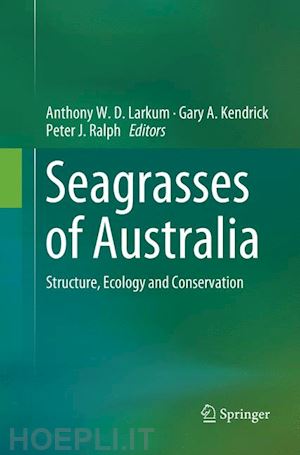

Questo prodotto usufruisce delle SPEDIZIONI GRATIS
selezionando l'opzione Corriere Veloce in fase di ordine.
Pagabile anche con Carta della cultura giovani e del merito, 18App Bonus Cultura e Carta del Docente
This book takes the place of “Biology of Seagrasses: A Treatise on the Biology of Seagrasses with Special Reference to the Australian Region”, co-edited by A.W.D. Larkum, A.J. MaCComb and S.A. Shepherd and published by Elsevier in 1989. The first book has been influential, but it is now 25 years since it was published and seagrass studies have progressed and developed considerably since then. The design of the current book follows in the steps of the first book.
There are chapters on taxonomy, floral biology, biogeography and regional studies. The regional studies emphasize the importance of Australia having over half of the world’s 62 species, including some ten species published for Australia since the previous book. There are a number of chapters on ecology and biogeography; fish biology and fisheries and dugong biology are prominent chapters. Physiological aspects again play an important part, including new knowledge on the role of hydrogen sulphide in sediments and on photosynthetic processes. Climate change, pollution and environmental degradation this time gain an even more important part of the book. Decline of seagrasses around Australia are also discussed in detail in several chapters. Since the first book was published two new areas have received special attention: blue carbon and genomic studies. Seagrasses are now known to be a very important player in the formation of blue carbon, i.e. carbon that has a long turnover time in soils and sediments. Alongside salt marshes and mangroves, seagrasses are now recognized as playing a very important role in the formation of blue carbon. And because Australia has such an abundance and variety of seagrasses, their role in blue carbon production and turnover is of great importance. The first whole genomes of seagrasses are now available and Australia has played an important role here. It appears that seagrasses have several different suites of genes as compared with other (land) plants and even in comparison with freshwater hydrophytes. This difference is leading to important molecular biological studies where the new knowledge will be important to the understanding and conservation of seagrass ecosystems in Australia. Thus by reason of its natural abundance of diverse seagrasses and a sophisticated seagrass research community in Australia it is possible to produce a book which will be attractive to marine biologists, coastal scientists and conservationists from many countries around the world.
A. Biogeography.- 1. Evolution and Biogeography of Australian Seagrasses; Anthony Larkum et al.- 2. Biogeography of Australian seagrasses NSW, Victoria, Tasmania and temperate Queensland; Peter Macreadie et al.- 3. Seagrasses of southern and south-western Australia; Kieryn Kilminster et al.- B. Taxonomy and Anatomy.- 4. Anatomy and Structure of Australian Seagrasses; John Kuo et al.- C. Molecular and Taxonomic Studies.- 5. Systematics and evolution of Australian seagrasses in a global context; Michelle Waycott et al.- 6. Genetic Connectivity in Tropical and Temperate Australian Seagrass Species; Kathryn McMahon et al.- D. Ecology.- 7. Seagrass dynamics and resilience; Rod Connolly et al.- 8. Reproductive, Dispersal and Recruitment Strategies in Australian Seagrasses; Craig Sherman et al.- 9. Australian Seagrass Seascapes: present understanding and future research directions; Gary A. Kendrick et al.- 10. Seagrass resistance to light deprivation: implications for resilience; Katherine O’Brien et al.- E. Physiology.- 11. Photosynthesis and Metabolism; Anthony Larkum et al.- 12. Microbiology of Seagrass habitats; Justin Seymour et al.- 13. Rhizome, Root/Sediment interactions, Aerenchyma and Internal Pressure Changes in Australian Seagrasses; Kasper Elgetti Brodersen et al.- 14. Seagrasses in the south-east Australian region – distribution, metabolism, and morphology in response to hydrodynamic, substrate, and water quality stressors; Angus Ferguson et al.- 15. Mapping, Monitoring and Modelling Seagrass; Stuart Phinn et al.- F. Fauna.- 16. The role of consumers in structuring seagrass communities: direct and indirect mechanisms; Robert J Nowicki et al.- 17. Faunal Assemblages of Seagrass Ecosystems; Paul York et al.- 18. The roles of seagrasses in structuring associated fish assemblages and fisheries; Glenn Hyndes et al.- 19. Dugongs: Seagrass community specialists; Helene Marsh et al.- G. Pollution & Global Climate Change.- 20. Decline and Restoration Ecology of Australian Seagrasses; John Statton et al.- 21. Global Warming and Ocean Acidification: Effects on Australian Seagrass Ecosystems; Ylva Olsen et al.- 22. Estimating seagrass blue carbon and policy implications: the Australian perspective; Peter J Ralph et al.- 23. Conclusions.- Appendix: Taxonomy of Australian Seagrasses; John Kuo et al.- Index.
Professor Gary Kendrick is a marine plant ecologist who is passionate about understanding how we both can protect and use our rich marine environments. He has multiple interests including understanding biodiversity and ecology of temperate and tropical seagrass meadows and reefs, conservation and restoration of marine foundation species, and educating people about coastal and marine ecosystems.
His experimental work on the ecology of seagrass meadows, kelp and Sargassum beds includes understanding the role of seagrasses and kelps in structuring communities, herbivory in seagrass meadows and reefs, and the effect of ocean warming and human impacts on the resilience of seagrasses and macroalgae.
Professor Kendrick has recently focussed on dispersal and recruitment ecology, and genetics of seagrasses, has measured and modelled the dispersal of seagrass seeds and documented seedling survival.











Il sito utilizza cookie ed altri strumenti di tracciamento che raccolgono informazioni dal dispositivo dell’utente. Oltre ai cookie tecnici ed analitici aggregati, strettamente necessari per il funzionamento di questo sito web, previo consenso dell’utente possono essere installati cookie di profilazione e marketing e cookie dei social media. Cliccando su “Accetto tutti i cookie” saranno attivate tutte le categorie di cookie. Per accettare solo deterninate categorie di cookie, cliccare invece su “Impostazioni cookie”. Chiudendo il banner o continuando a navigare saranno installati solo cookie tecnici. Per maggiori dettagli, consultare la Cookie Policy.